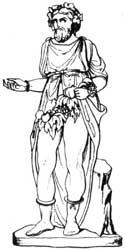Priapus

A son of Dionysus and Aphrodite.1 Aphrodite, it is said, had yielded to the embraces of Dionysus, but during his expedition to India, she became faithless to him, and lived with Adonis. On Dionysus' return from India, she indeed went to meet him, but soon left him again, and went to Lampsacus on the Hellespont, to give birth to the child of the god. But Hera, dissatisfied with her conduct, touched her, and, by her magic power, caused Aphrodite to give birth to a child of extreme ugliness, and with unusually large genitals. This child was Priapus. According to others, however, Priapus was a son of Dionysus and a naiad or Chione, and gave his name to the town of Priapus,2 while others again describe him as a son of Adonis, by Aphrodite,3 as a son of Hermes,4 or as the son of a long-eared father, that is, of Pan or a satyr.5
The earliest Greek poets, such as Homer, Hesiod, and others, do not mention this divinity, and Strabo6 expressly states, that it was only in later times that he was honored with divine worship, and that he was worshiped more especially at Lampsacus on the Hellespont, whence he is sometimes called Hellespontiacus.7
We have every reason to believe that he was regarded as the promoter of fertility both of the vegetation and of all animals connected with an agricultural life, and in this capacity he was worshiped as the protector of flocks of sheep and goats, of bees, the vine, all garden-produce, and even of fishing.8 Like other divinities presiding over agricultural pursuits, he was believed to be possessed of prophetic powers, and is sometimes mentioned in the plural.9 As Priapus had many attributes in common with other gods of fertility, the Orphics identified him with their mystic Dionysus, Hermes, Helios, etc.10
The Attic legends connect Priapus with such sensual and licentious beings as Conisalus, Orthanes, and Tychon.11 In like manner he was confounded by the Italians with Mutunus or Muttunus, the personification of the fructifying power in nature.12 The sacrifices offered to him consisted of the first-fruits of gardens, vineyards, and fields,13 of milk, honey, cakes, rams, asses, and fishes.14
❧
Iconography
Priapus was represented in carved images, mostly in the form of hermae, with very large genitals, carrying fruit in his garment, and either a sickle or cornucopia in his hand.15 The hermae of Priapus in Italy, like those of other rustic divinities, were usually painted red, whence the god is called ruber or rubicundus.16
References
Notes
- Pausanias. Description of Greece ix, 31.2; Diodorus Siculus, iv, 6; Tibullus, i, 4.7; Scholiast on Apollonius Rhodius, i, 932.
- Strabo. Geography xiii, 587; Scholiast on Theocritus, i, 21.
- Tzetzes on Lycophron, 831.
- Hyginus. Fabulae, 160.
- Macrobius. Saturnalia vi, 5.
- xiii, 558.
- Ovid. Fasti i, 440; vi, 341; Arnobius, iii, 10.
- Pausanias. Description of Greece ix, 31.2; Virgil. Eclogues vii, 33; Georgics iv, 110, with the commentators.
- Tibullus, i, 4. 67; Moschus, iii, 27.
- Scholiast on Theocritus, i, 21; Eustathius on Homer, pp. 691, 242.
- Strabo. Geography l.c.; Aristophanes. Lysistrata, 982; comp. Diodorus Siculus, iv, 6.
- Salmasius on Solinus, 219; Arnobius, iv, 11.
- Anthology Palatine vi, 102.
- ibid. x, 14; Ovid. Fasti i, 391, 416; Servius on Virgil's Georgics ii, 84.
- Tibullus, i, 1.22, 4.8; Virgil. Georgics iv, 110; Horace. Satires i, 8.
- Ovid. Fasti i, 415; vi, 319, 333.
Source
- Smith, William. (1870). Dictionary of Greek and Roman Biography and Mythology. London: Taylor, Walton, and Maberly.
This article incorporates text from Dictionary of Greek and Roman Biography and Mythology (1870) by William Smith, which is in the public domain.